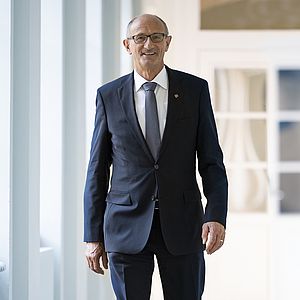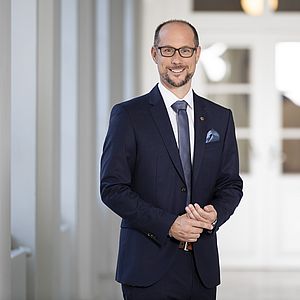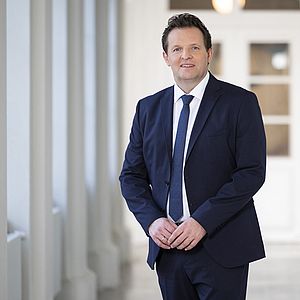Building a centre of power
The completion of the New Landhaus project was the product of a lawless environment. The Nazi leadership paid only lip service to the provisions of the building regulations. Contracts were awarded only to companies with Nazi affiliations. After a construction period of just one year, the various party officials and agencies were installed in their new offices. Following the topping-out ceremony in May 1939, however, the discrepancy between propaganda and reality became increasingly apparent. While the reports spoke of a “proud landmark of the capital of the Gau”, the building met with a completely negative response from the party leadership beyond the borders of Tyrol, and they forbade the use of the word “Gauhaus”.
The office of the Gauleiter also had a plan to purchase all the residential properties in the Landhaus ensemble so as to create a self-contained centre of power. The whole project was criminal in its execution. The finance was generated by plunder taken from the institutions of the Church. Acquisition of the residential properties needed for the Landhaus ensemble was made possible by first expropriating Innsbruck’s Jewish residents and then offering “aryanised” buildings in exchange for the desired properties in addition to financial compensation.
Legal and administrativ
1. Objection to the height of the building lodged by the neighbouring Schirmer family in April 1939, TLA
2. Former school building opposite the east façade of the new building on Wilhelm-Greil-Strasse, StAI
3. Contractors’ construction site boards, TLA
4. Confidential circular sent by the Gauleiter in July 1941 regarding the award of public contracts, TLA
5. Letter sent by the head of the Building Construction Department in September 1939 on the use of forced labour, TLA
1. Without compromise
The on-site planning permission hearing took place on 12 September 1938. It had a purely alibi function; the contract with the Hinteregger construction company had already been signed, and objections were simply not considered. The Schirmer family as owners of a neighbouring property were not even invited to the hearing.
2. One hand washes the other
The municipal authorities raised objections to the new building: It was too high and the design of the south façade was unsatisfactory. But the municipality was dependent on the good will of the Governor’s office. Permission was required for an extension to the town hall, which was planned at the same time. Similarly, demolition of the former school building was needed to make Wilhelm-Greil-Strasse more straight.
3./4./5. Award of contracts and the question of forced labour
Two weeks after the start of the war, the Building Department was already discussing the use of forced labour, which could not be ruled out for later construction work. Several contractors employed slave labourers and prisoners of war.
Propaganda and reality
1. Photographs of the topping-out ceremony, 6 May 1939, TLM
2. Newspaper reports on the construction of the Gauhaus, 1938/39, ANNO/ÖNB
3. Propagandistic “before” and “after” comparison in the “Deutsche Volkszeitung”, 31 August 1938
4. Front-page story in the “Deutsche Volkszeitung” on the occasion of Hitler’s visit to Innsbruck in April 1938
5. Reich Organisation Leader Robert Ley in front of the Hofburg, May 1939, “Innsbrucker Nachrichten”
6. Directive relating to the name of the new administration building, August 1939, TLA
1. “Hallmark” of the city
At the topping-out ceremony on 6 May 1939, Gauleiter Hofer, numerous party and state officials and master builder Hinteregger toasted what they saw as the success of the project. Construction workers and the Wilten Brass Band were lined up in front of the building decorated with swastika flags and pine branches.
2./3./4. The spin
In the media, the new building was cast as a “demonstration of National Socialist determination and energy” and a symbol of the dawning of a new age. The Nazi spin was always the same: After years of stagnation, Hitler brings you work and bread.
5./6. Extension instead of Gauhaus
Reichsleiter Robert Ley paid a short visit to Innsbruck four days after the topping-out ceremony. His approval was essential for the new building to be funded by the NSDAP. But Ley considered the building totally unsatisfactory, referring to it as a “monastery with cells”, and forbade further use of the name “Gauhaus”.
Finance and barter
1. Payment order to the Tyrolean regional treasury to cover the construction costs, October 1938, TLA
2. The Canisianum, the Catholic boarding school run by the Jesuit Order for students of theology, before 1938, StAI
3. Letter from the Reich Ministry of Finance on the repayment of a loan, September 1941, TLA
4. Site plan of the surroundings of the Landhaus perimeter block, August 1938, TLA
5. Protocol on the sale of the Schirmer residence on Meraner Strasse 4 (excerpt), TLA
6. The Graubart shoe shop at Museumstrasse 8, April 1938, StAI
7. Vera Graubart with her parents Margarethe and Richard, private archive of the Graubart family
1. Construction on credit
The burden on the budget of Tyrol was enormous: Construction costs amounted to 2.5 million Reichsmarks. At least 1 million Reichsmarks were needed for the purchase of real estate and adaptation work. Financing for the project was based on credit and hopes of future funds from Berlin.
2./3. Daylight robbery
It is no longer possible to determine exactly where all the money came from. The Tyrolean authorities received a loan of 800,000 Reichsmark from Berlin. Repayment of the loan was avoided through expropriation of the Canisianum, which the Gauleiter’s office sold to the German Reich for 1.5 million Reichsmarks.
4. Power centre and aryanisation
In order to create a self-contained power centre around the Old Landhaus, the Gauleiter’s office acquired neighbouring private properties (marked in yellow). The owners did not want to sell. In exchange, the Nazi leaders offered them the homes of evicted Innsbruck Jews at a bargain price.
5./6./7. Profit out of persecution
The Schirmer family benefitted fortuitously from the compulsory sale of their home. Although they asked for more than they ultimately received, they also acquired the Graubart property at Museumstrasse 8. Richard Graubart was murdered on the night of the November pogrom. His wife Margarethe and daughter Vera fled to England.








